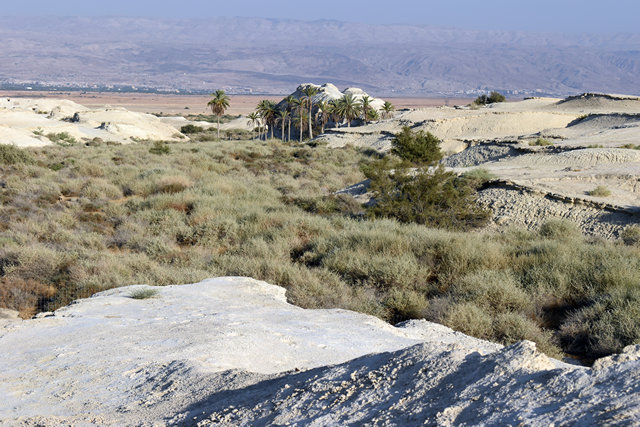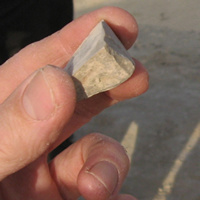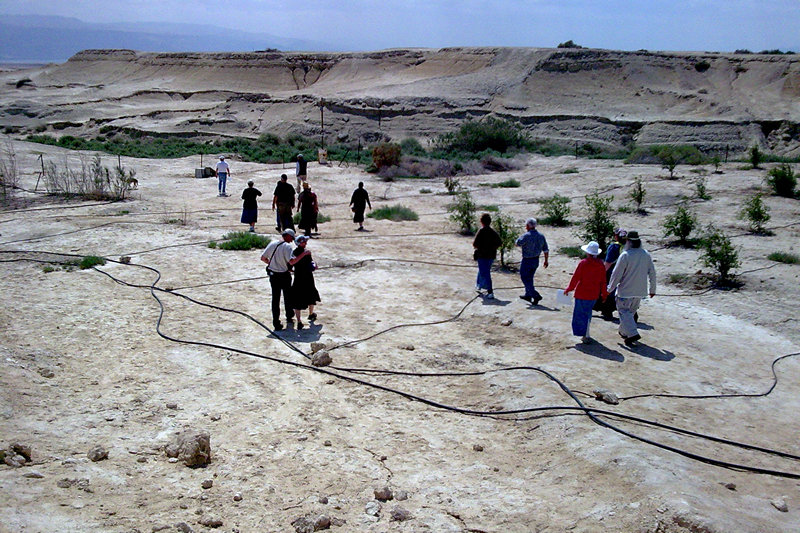History and Tradition
By: . Some parts based on a Hebrew article by .

After crossing the Jordan River into the Land of Israel under the leadership of Joshua bin Nun (Joshua 3:11-17), the Children of Israel set-up camp in the Plains of Jericho (a large plain bounded on the east by the Jordan River, on the south by the Dead Sea and on the west and north by the mountain range just west of the yet unconquered city of Jericho). The place of the encampment was called "the Gilgal"(Joshua 4:19), because the entire Jewish People circumcised themselves there (all those born in the 40-year desert wandering): "Today I revealed (Goloti) the shame of Egypt from amongst you"
(Joshua 5:9).

flintstones found in the area
The extraordinary quantity of sharpened flintstones found in the area bears witness to the mass circumcision which took place here: "HaShem said to Joshua: Make sharp knives and circumcise the Children of Israel again. Joshua made sharp knives and circumcised the Children of Israel at the Givat HaÁralot" [Givat HaÁralot = the mound of foreskins situated within the Gilgal encampment]
(Joshua 5:2-3).
When the Cohanim priests crossed the Jordan River, twelve stones (nothing to do with the aforementioned flintstones) were taken across from the east bank of the river (Joshua 4:2). These twelve stones are an eternal sign that the Children of Israel crossed the Jordan River on dry land (Joshua 4:6-7).
Subsequently, Joshua erected the Tabernacle in the Gilgal, where it stood for 14 years before being moved to Shiloh (Joshua 18:1). However, the sanctity of the Gilgal endured throughout the generations. King Saul was crowned in the Gilgal by the Prophet Samuel who went out of his way to journey there for the event (Samuel I 11:14). It is related in the Babylonian Talmud (Tractate Sanhedrin, page 21b), that the Prophet Samuel chose to hold the coronation in the Gilgal because Israel had been commanded to appoint a king after entering the Land. As the Gilgal had been the entry point to the Land, it was appropriate to hold the coronation there. The Biblical commentators Radak and Kaftor Ve Perach hold that, because Joshua had initially placed the Ark and the Tabernacle in the Gilgal when entering the Land, the place was a sacred site, and appropriate for holding the coronation.
And in sharp contrast, places of idolatrous worship were erected in the Gilgal during the reigns of various kings of Judah.
The Gilgal was Israel's base camp, in which they circumcised themselves and celebrated their first Passover in the Land (5 days after crossing the Jordan). After the end of 7-day Passover holiday, they went to conquer Jericho, circling the city once every day, and then 7 times on the seventh day. All these events are detailed below.
The sequence of events between the crossing of the Jordan and the conquest of Jericho
- The events leading to the crossing of the Jordan are explained here.
- 10th Nissan: The Jordan river stops flowing and the Children of Israel cross over on the river bed from the Plains of Moab on the east bank of the Jordan to the Plains of Jericho on the west bank of the Jordan (Joshua 3:16-17).
- 10th Nissan: After having crossed the Jordan, the Children of Israel set-up camp in The Gilgal, which is in the Plains of Jericho (Joshua 4:19).
- 11th Nissan: All men born during the 40-year wandering in the desert (who had not been circumcised) are now circumcised with sharp flintstones (Joshua 5:2).
- 14th Nissan: After recovering from the circumcision during three days, the Children of Israel are ready to offer the Passover Sacrifice, the first Passover sacrifice offered in the Land of Israel (Joshua 5:10).
- 15th to 21st Nissan: The Children of Israel celebrate the seven days of Passover following the offering of the Passover Sacrifice, in their Gilgal encampment.
- 21st to 27th Nissan: Joshua circles the city of Jericho, once every day with the Ark, his warriors and the Priests (Cohanim), blowing their Shofars (Joshua 6:3-14).
- 28th Nissan: Joshua circles the city of Jericho 7 times, together with the Ark, his warriors and the Priests (Cohanim), blowing their Shofars. On the 7th encirclement, the walls of the city sink into the ground, and the conquest starts (Joshua 6:15-20).
As a concluding remark, the Jordan Valley between the Sea of Galilee and the Dead Sea, which includes the Biblical Gilgal and the site of the Jordan Crossing at its heart, is not “the land of the monasteries”, as is often advertised in tourist publications, but a foundational part of Jewish history and tradition.






